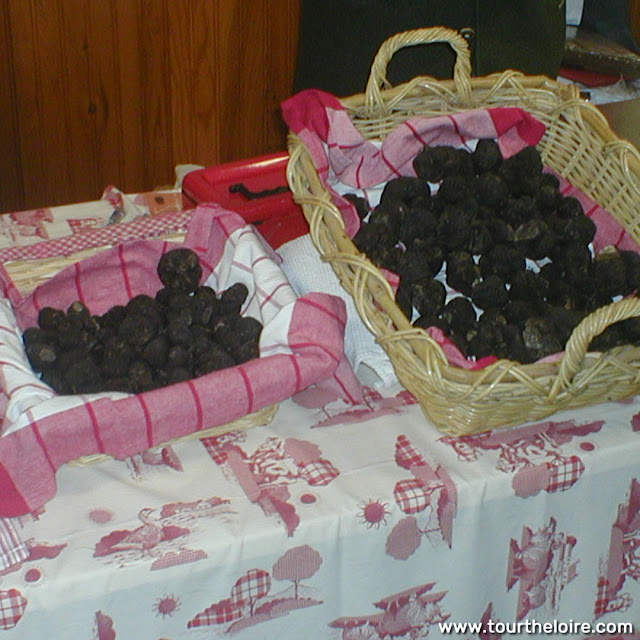Black Truffle Tuber melanosporum (Fr. Truffe noire) is native to the Loire Valley, but has long since disappeared from the wild. According to the experts and old timers the best place to find truffles was under isolated oak trees in the middle of wheat fields, but fifty years of modern farming practices and fungicides sprayed on wheat crops have destroyed the habitat for truffles. The truffles benefitted from the disturbance of the soil with the plough and the minor damage done to the tree roots, allowing the truffle mycelium to latch on, providing the conduit for a symbiotic exchange of nutrients. It may explain why isolated mature oak trees in the middle of fields continue to be a not uncommon sight in the Touraine.
 |
| Oak trees dotted about the fields. |
Nowadays, because of their extirpation in the wild, truffles are cultivated, in orchards planted with inoculated oak trees. Black Truffles fruit in the winter, and over winter there is a series of specialist markets in the otherwise undistinguished village of Marigny-Marmande.
 |
| Truffle orchard. |
Local growers tell me that alternating wet and warm weather from May to July is crucial to ensuring a good truffle harvest over the winter, from November to February, so I assume the harvest this winter is expected to be poor because of the drought. The markets before Christmas double as general seasonal gourmet markets, with other producers there to sell their venison, snails, nuts and dried fruits, preserves, winter pork and poultry products and cheeses, speciality breads, honey and wines. The markets after Christmas are all about the truffles, with far fewer stalls, and tree whips inoculated with truffle spores available for those who want to try a few in their garden for fun. Serious truffle buyers come in January, when the quality of the truffles is at its best. About 20 – 35 tonnes of truffles are harvested these days in the Loire Valley, which the area a major player nowadays. Back in 1900 the harvest of wild truffles here was a thousand tonnes.
 |
| Black truffles at the specialist market in Marigny-Marmande. |
Anyone with a truffle orchard is playing a long game. The trees will take at least ten years to produce a truffle, and some may never do so. Others will go on to produce truffles for thirty years or more. My friendly local truffle guru tells me that a good truffle orchard has a mixture of the local species of oak, and the evergreen species that is native to the south of France. The local oak is small, deciduous and adapted to the local poor dry chalky soils and will produce truffles earlier than the evergreen species, but is weakened by the truffles and has a shorter lifespan than the evergreens. He owns two lively truffle hounds, a Jack Russell called Pierre, and a wire haired dachshund called Odile. Truffle hounds can be any breed of dog, and are trained by getting them to play fetch with a truffle oil impregnated sparkling wine cork.
The cultivation and commercialisation of truffles came about in the late 19th century because so many vines were grubbed up due to phylloxera. Instead of vines, farmers planted oaks. They understood that the trees would quite likely have truffles attach themselves to the roots. But by the end of World War One there was no labour to work on the land, then the Depression and another World War, and the trees had reached the end of their productive life. So truffles became once again scarce and expensive.
Truffle orchards began being planted again in the 1970s, often by bourgeois enthusiasts at their country homes, keen to revive a tradition. INRA, the French national agronomy research institute, developed a technique of inoculation of oak and hazel saplings that resulted in a quarter of the trees producing truffles within a decade. Today 90% of French truffles are cultivated and there are about 20 000 truffle farmers in France. Drought and wild boars are the biggest problems that they face. The reason pigs are such good truffle hunters is that the aroma of truffle is the same as boar pheromones, so the sows go crazy for them. In the wild it means the truffles can spread due to the boars ploughing.

No comments:
Post a Comment